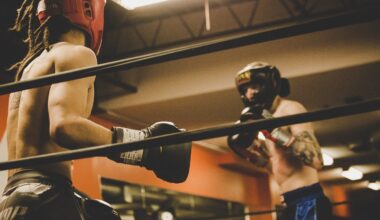Kneeboarding Competitions: What to Expect and How to Participate
Kneeboarding competitions are exciting events that showcase the skills, agility, and creativity of competitors. Events are typically held in various scenic locations, allowing participants to display their talents in breathtaking settings. Whether you are a novice or a seasoned expert, these competitions host categories suited to various skill levels, ensuring everyone can participate and enjoy the experience. During the events, competitors perform tricks and stunts as they are towed behind a boat, aiming to impress the judges with their technique and style. Technical skills such as balance, speed control, and trick execution are crucial for success. Judges score each competitor based on criteria, so practicing is essential. There are different formats for kneeboarding competitions, including freestyle and slalom events. Attending competitions allows you to connect with fellow enthusiasts and learn from the best in the field. Spectators often gather, making a vibrant atmosphere filled with excitement and camaraderie among kneeboarding fans. If you’re contemplating participation, readiness to put your skills to the test is vital to ensuring an enjoyable experience in the world of kneeboarding.
This sport can be incredibly rewarding and offers numerous benefits beyond just competition. One of the main advantages is the improvement of physical fitness. Kneeboarding is a full-body workout that enhances strength, coordination, and overall cardiovascular health. As you hone your skills in kneeboarding, your core muscle strength improves, which is vital for maintaining balance on the board while performing tricks. Additionally, the social aspect of kneeboarding cannot be overstated. Competitions often attract participants and viewers from diverse backgrounds, promoting a sense of community and inclusion. You will likely make lasting friendships with fervent individuals who share similar passions for water sports. Kneeboarding also provides an excellent opportunity for personal growth. Competing allows you to challenge yourself, which instills confidence and self-discipline. The adrenaline rush you experience as you perform in front of an audience can be exhilarating, creating memories that last a lifetime. With every competition, there seems to be increasing camaraderie among participants, and building relationships on the water can lead to lifelong friendships that often extend well beyond the kneeboarding environment.
Preparing for Your First Competition
Before diving into a kneeboarding competition, some essential preparation steps can set you up for success. First, familiarize yourself with the event rules and regulations set by the organizing body. Each competition may have different requirements regarding tricks, gear, and expected performance levels. Knowing what to expect will help ease pre-event jitters. Train regularly to practice your skills, focusing on both backs and tricks and developing the ability to adapt to various conditions. Finding a coach or experienced mentor can be beneficial, as they can provide guidance, feedback, and essential tips to improve your technique. Another crucial step is ensuring your gear is in peak condition. Check your kneeboard, bindings, and tow rope for any wear or damage and replace them if necessary. Attend some local competitions as a spectator prior to your own to observe how things unfold and pick up useful insights from seasoned competitors. Finally, have a mental plan for competition day. Visualizing your performance can supercharge your confidence and readiness for the exhilarations of common competition scenarios. Proper preparation can make a significant difference in your overall performance.
Understanding the judging criteria is essential for participants to achieve optimal performance in kneeboarding competitions. Judges assess various aspects, including technical execution, creativity, and overall performance flow. Knowing how judges score competitors helps you tailor your routines effectively. Technical execution encompasses aspects such as clean landings, smooth transitions, and stable performance throughout your run. Creativity is evaluated through the originality of tricks, diversity in moves, and the ability to combine elements smoothly. The overall performance flow considers factors like rhythm and pacing while on the water. Therefore, creating a routine that showcases your strengths while adhering to these criteria will likely yield a higher score. Consider incorporating entertaining and challenging moves that stand out while ensuring they align with the competition rules. Engaging your audience and the judges can make your performance memorable. During your routine, maintaining good eye contact, facial expressions, and body language can enhance your overall presence. Rehearsing in simulated competition conditions is crucial for refining your routine and testing out how it works under pressure. Focus on what you can control and practice mental fortitude while competing; this can be the difference between succeeding and feeling overwhelmed.
Post-Competition: What to Do Next
After participating in a kneeboarding competition, it’s essential to create a plan to evaluate your performance and continue growing as an athlete. Take time to reflect on your experience, considering what aspects went well and areas where improvements are needed. Detailed notes can help you assess your performance objectively. Engage with fellow participants to share experiences and learn from their insights. Constructive feedback from experienced competitors can provide valuable lessons for future competitions. It’s important to celebrate your achievements too, regardless of placement. Every competition provides an opportunity for progress, and recognizing growth fosters motivation for improvement. Consider setting new goals based on your post-competition reflections. Whether focusing on refining existing skills or attempting new tricks, make plans to ensure your next competition experience is more rewarding. Additionally, maintaining regular practice schedules is crucial for long-term improvement. Staying consistent with your training while also allowing time for rest ensures you achieve the balance needed for sustained success. Connecting with the kneeboarding community can also provide invaluable networking opportunities and gain access to resources that can improve your skills and technique over time.
To excel in kneeboarding competitions, maintaining a positive mindset and mental resilience is paramount. The pressure associated with performing in front of spectators and judges can sometimes be overwhelming. Building confidence through visualization and positive affirmations can help calm nerves before taking to the water. Moreover, understanding that every competition is a learning opportunity enables you to approach them with an open mind. Celebrate small successes and improvements while recognizing that not every performance is perfect. Accepting setbacks as a part of the journey allows you to remain motivated and focused despite outcomes. Practicing mindfulness techniques can also assist in managing stress levels during competitions. Preparing accordingly and employing strategies to regulate your excitement, anxiety, or fear can enhance your overall performance. Stay engaged with fellow participants and make connections that create support networks during competitions. Emphasizing joy and gratitude in your practice can help keep your motivations intact. Remember, kneeboarding should be, above all, fun. Maintaining this perspective fosters a love for the sport that transcends competition outcomes. By focusing on the experience and camaraderie, you’ll find that each event becomes increasingly rewarding.
The Future of Kneeboarding Competitions
The future of kneeboarding competitions looks bright, with increasing popularity among water sports enthusiasts and advancements in technology. As more participants embrace the sport, competitions are becoming more frequent and accessible, catering to various skill levels and backgrounds. Formats may evolve to include new trick categories, indoor competitions, or virtual events using advanced simulation technology. These changes could broaden the reach of kneeboarding, attracting a diverse audience and participants. Additionally, organizations are likely to develop new training programs and clinics to promote skill development among aspiring kneeboarders. Opportunities for sponsorship and media coverage of events could also increase, leading to greater exposure and potential support for competitors. With social media’s rise, showcasing talents and experiences can motivate future athletes while inspiring new competitors to enter the sport. Engaging the community through exciting events and initiatives, such as charity competitions or youth outreach programs, will further promote kneeboarding. Ultimately, the evolution of kneeboarding competitions hinges on community involvement and the willingness to embrace new combinations of technology and performance styles. Such positive trends signal a promising tomorrow for kneeboarding competitions.
Whether you’re a participant or a spectator, kneeboarding competitions present an exhilarating experience well worth exploring. Gather your gear, get on the water, and witness the thrill of kneeboarding firsthand then become part of this vibrant community. Remember that each competition brings opportunities to learn, grow, and connect with passionate individuals. Embrace the spirit of kneeboarding and enjoy the journey as you dive into the challenges and excitement that await in the world of kneeboarding competitions.


